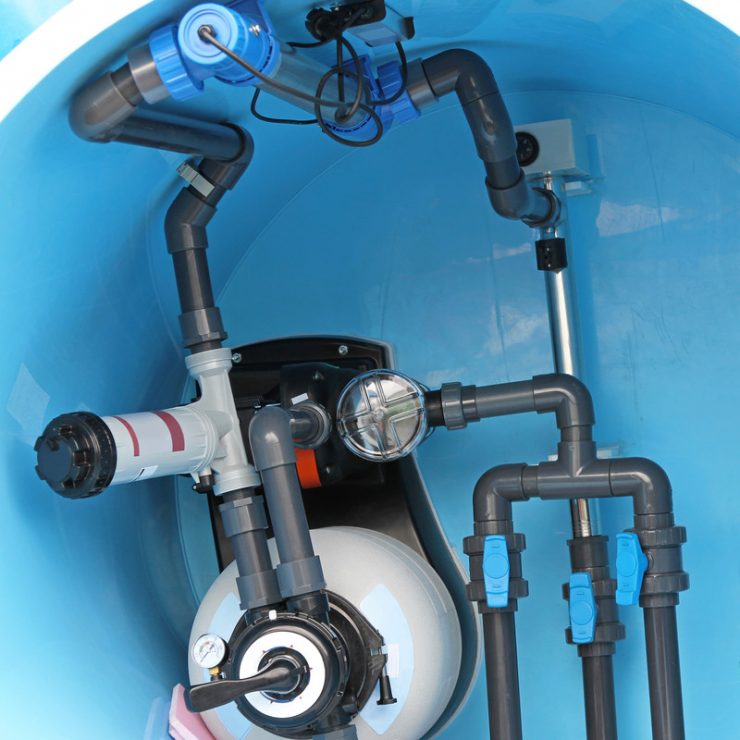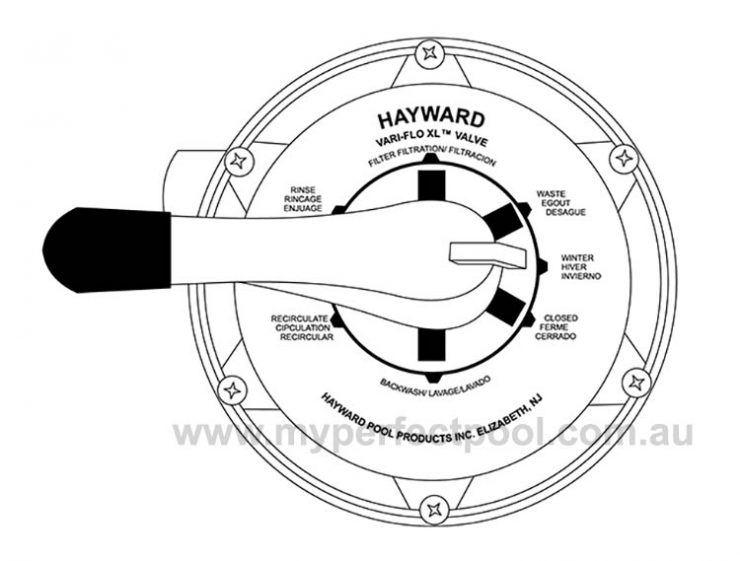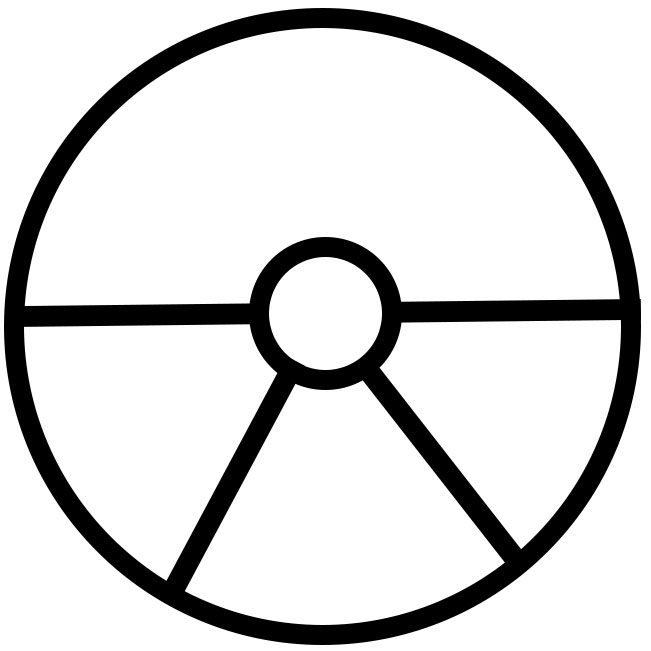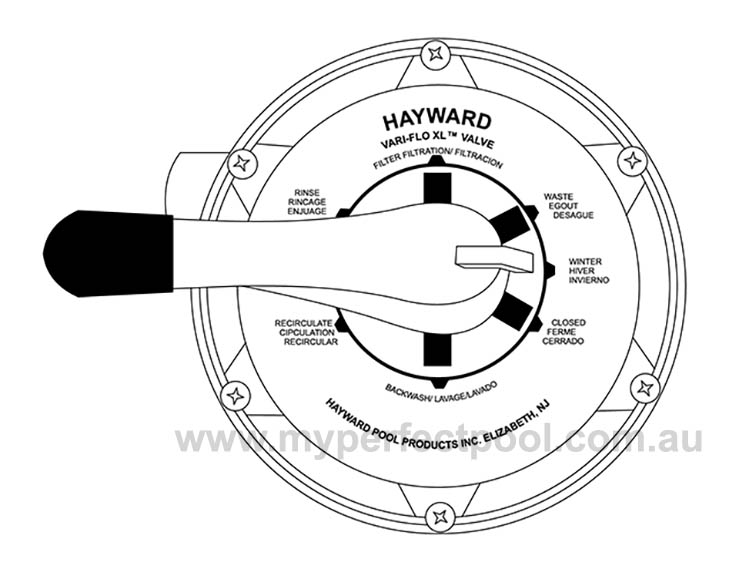Water should only come out of the backwash line (waste outline) when the multiport valve is set to backwash. If you notice pool water flowing out of a backwash hose when the multiport valve is on any other setting but backwash, it’s an indication of a leak.
So how do you spot the cause of and fix the leak? That’s what this post discusses. So let’s dive in.

Article Contents
Why is The Pool Filter Leaking From The Backwash Hose or Line?
Water leaking out of the backwash port, hose or backwash line (aka waste line) is a common problem with sand filters and DE filters. When you run your pool filter, there should be no water coming out of the backwash hose or outlet unless you are backwashing your filter or have just finished the backwash process.
This means there should be no water coming out of the backwash or waste outlet when the filter valve is set to:
- Filter
- Rinse
- Recirculate
- Winter
- Closed
There are a few reasons your pool backwash hose might be leaking when the multiport valve isn’t set to backwash. Let’s check out the most common reasons for this and why they occur.
1) Displaced Spider Gasket
- Fixes leaks, low pressure & backwash issues
- Range of seals suitable for all filters
- Cheap & simple to replace
The spider gasket in your pool filter system is also called the spoke gasket. This gasket is located in the multiport valve (the big valve that you select the filter functions) diverter, and it is designed to ensure proper circulation of water in the pool.

The spoke gasket works together with the multiport valve. Whenever the multiport valve is set on “filter”, the spoke gasket serves to seal off the other chambers inside the valve and ensures water only flows through the intended route and not through the backwash lines.
Now, if the spider gasket is displaced or stuck, there will be nothing sealing the different routes the water could take in the valve, meaning that water will flow to ports where it is not supposed to. So when you set the multiport valve to “filter“, water may leak through the backwash hose or into other pool lines or pipes, where it isn’t supposed to go.
So what causes a displaced spider gasket?
What Causes A Displaced Spider Gasket?
There are three common reasons for a displaced spider gasket.
- Changing between filter settings without turning the pump off.
- Changing to another setting on the multiport valve too quickly after the previous setting.
- Long-term use or poor maintenance can also cause the gasket to become weak and out of position.
- Wear and Tear
Related Reading: How to Replace a Spider Gasket in Multiport Valve
2) Sand or Dirt Build-up Around The Spider Gasket
Sand or dirt build-up around the multiport valve, diverter, or spider (aka spoke) gasket can cause water to leak out of the backwash line when the pool is set on “filter“. This is very common with sand filters and Diatomaceous Earth (DE) filters.
When there is a build-up of debris in or around the spoke gasket, it becomes difficult for the spoke gasket to seal tightly.
So when the pool multiport is set on “filter” or any other setting, water can escape through the backwash or waste, since the spider gasket (aka spoke gasket) designed to stop this isn’t sealed tightly due to debris accumulation in the housing. So why does this happen?
Why does Debris Accumulate Around The Spoke Gasket?
The main reason this happens is due to poor maintenance and cleaning. Other reasons include:
- Murky pool water
- Filling the pool with water that has a high solid or waste content
- Lack of cleaning the multiport valve
3) Damaged Spider (Spoke Gasket)
Another reason for a leak through the backwash hose is if the spider gasket (spoke gasket) is damaged or worn out. A damaged spider gasket will be unable to carry out its functions. Also, it will take very little water pressure to move a damaged or worn-out spider gasket out of place.
Why Does The Spider Gasket Get Damaged?
The common reason for a damaged, torn, or worn-out spider gasket is long-term use. Over time, the spider gasket will deteriorate. Other reasons for this include:
- Debris in the multiport valve housing
- Incorrect pH level or too much chlorine
- Adding chemicals directly through the skimmer housing.
4) Loose Compression Spring
The compression spring is located in the multiport valve. The spring presses down on the spider gasket, creating a watertight seal, preventing water from leaking through the backwash hose or into other parts of the valve.
If the spring has lost its force and is weak, water can escape through the backwash hose even when the pool’s multiport valve isn’t set on backwash or waste. This is because a weak compression spring will not hold the spider gasket down properly. So what causes a loose compression spiting?
What Causes a Loose Compression Spring?
Every time you change the settings on the multiport valve, the compression spring is used to position the spoke gasket in place for proper water circulation.
This causes gradual wear on the spring and eventually, it will lose force, causing the spider gasket to be poorly sealed.
Chemical corrosion or etching from too many pool chemicals can also cause the compression spring to break.
And general everyday use will eventually fatigue the spring and cause it to weaken or break.
5) Twisted Spoke/Spider Gasket
The spider gasket is made from flexible materials. If the gasket becomes entangled or twisted, it will create small holes or openings in the gasket that will allow water to escape through the backwash hose. Why does this happen?
What Causes A Twisted Spider Gasket?
- Large debris in the filter being forced through the spider gasket
- Low water temperatures, especially during the cold winter months, can cause the spider gasket to shrink and get twisted. But this only happens when you don’t winterize your pool.
Speaking of winterizing your pool, check out this article on the website to learn the easy way to winterize.
So now you know the causes of a leak through the backwash lines, let’s find out the solutions.
6. Cracked or Broken Multiport Valve
- Valves to suit all filters
- Fix all multiport valve problems
- Saver time & money with a replacement
The above solutions list some parts inside the multiport valve that can break or wear out. The valve housing itself can also wear out and break.
It’s common for multiport valves to crack over time. And if the crack is inside the valve, this can allow water into the backwash or waste hose when it’s not supposed to be there.
What causes a cracked or broken multiport valve?
As with any moving part, eventually, they wear out. Your multiport valve is no different. With regular use, the valve is moved into different positions and has to withstand the forces of the movement as well as the pressure of the water.
In addition to this, the multiport valve is exposed to strong chemicals such as chlorine and acids, and often sunlight. All of these things take a toll on the valve and weaken the plastic, which means eventually, it will crack or break completely.
Related Reading: What Do All the Multiport Valve Pool Filters Settings Do?
How To Fix A Pool Filter Leak From The Backwash Hose or Line
To fix a leak from the backwash hose or waste line, you need to first identify the problem. There are a few possible causes as listed above, but in most cases, the culprit is usually the spider gasket. This will also be the cheapest thing to repair, so the first thing to do is to check the gasket.
Follow the written instructions below or if you prefer, here’s a video showing the whole process.
1. Turn off the pool pump & release filter pressure
When you turn off the pump make sure it’s off at the breaker so it doesn’t come back on when working on it. Don’t forget to reset your pool timer when finished as it will stop when you turn off the breaker.
Release the pressure from the filter by opening the pressure release valve on the top or side of the filter.
2. Remove the multiport valve fastening screws
You can find the screws on the top of the valve as shown in this picture.

3. Remove the multiport vale and spider gasket
Now you can pull the valve out of the housing. When the valve is out, pull the spider gasket out too.
4. Inspect the spider gasket for damage
The spider gasket should be sitting properly in the ports. If it appears displaced or out of position, then that is the cause of the leak.
Also, the spider gasket should be in good condition. This means it shouldn’t be worn out, cracked, perished, torn, or damaged in any way.
It’s best to replace the gasket if it is displaced and you should definitely replace it if it’s damaged. And while you’re at it, replace the multiport valve head o-ring.
If the spider gasket isn’t damage or displaced, cleaning it is all you need. See further instructions below.
5. Inspect the compression spring
Inside the valve, you’ll see a large spring and some washers. Make sure the spring or washers is not deformed or broken. Replace the parts if this is the case.
6. Clean the multiport valve housing
Next you need to clean all the surfaces that the spider gasket sits on. Use a plastic scraper to do this so you don’t damage the housing. Remember to do both the top and bottom sides.
You could also dismantle the handle and remove the spring whilst your there for cleaning. These surfaces also get dirty and can cause problem.
7. Replace the spider gasket
With the valve housing all clean, put the new spider (spoke) gasket in paying attention to line it up to the chambers.
Tip: use some vinyl glue on both sides of the gasket to keep it in place.
8. Reassemble the multiport valve
Put the lid back on and tighten the screws back up. Make sure you close the filter pressure release valve. If you used glue on the gasket, leave it for 24 hours before starting the pump again.
Now you can try out each position of the valve making sure they move correctly and there is no water escaping from the backwash line (when you’re not using backwash setting).
You have now fixed your pool filter leaking from the back wash hose!
Pro-Tips To Prevent Pool Filter From Leaking Through Backwash Hose
- Glue the spider gasket to the ports to prevent it from moving out of place
- Always turn off the pool pump before changing the multiport valve settings
- Clean and maintain the skimmer, multiport, and spider gasket housing regularly
- Always check the o-rings on the multiport valve lid as this can cause leaks too.
Final Words
Overall, a pool filter leak through the backwash hose is nothing to panic about. Using this guide, you’ll be able to easily fix the problem yourself.
So there you have it. If you found this post helpful, ensure to check out other interesting posts on this website for more pool tips.




Hi. I’ve replaced the entire multi valve and am still experiencing significant water leak from the backwash line of my hayward sand filter whenever i have the pump running. What else should I try to stop the leak. Thank you in advance for any assistance you can provide.
If you’ve already replaced the entire multi-valve and are still experiencing a significant water leak from the backwash line of your Hayward sand filter, there are a few potential causes and troubleshooting steps you can take:
1) Check the connections: Ensure that all connections, including the ones from the backwash line to the multi-valve and from the multi-valve to the filter tank, are properly tightened and sealed. Sometimes, a loose or improperly sealed connection can cause leaks.
2) Inspect the backwash line: Look for any cracks, breaks, or damage to the backwash line itself. If the line is damaged, it may need to be replaced.
3) Inspect the filter tank: Examine the tank for any cracks, damage, or signs of wear that could be causing the leak. If you find any issues, you may need to replace the tank.
4) Check the O-rings and gaskets: Inspect the O-rings and gaskets on the multi-valve and filter tank. Over time, these can degrade and lose their effectiveness, leading to leaks. Replace any damaged or worn O-rings or gaskets.
5) Check the Pressure: Ensure the filter pressure isn’t too high as excess pressure could be putting additional strain on the connections.
When fixing the spider gauge to stop backwash hose from leaking do you have to take water out of pool?? When you take off the top will the water gush out?
No you don’t need to take the water out of the pool. If the filter is above the pool level, only a little water will come out. If the filter is below the pool level, shut off the valve from the pool to the filter/pump first.
I now have the confidence to open the top and get to look at the ‘spider gasket’.
I am having this problem with a new multi valve unit. I was also having this problem with my old unit. So Hayward sent me replacement. Would old sand be the issue. I did not change it this year.
Very helpful and precise instructions followed them and that was the problem thanks and bless you